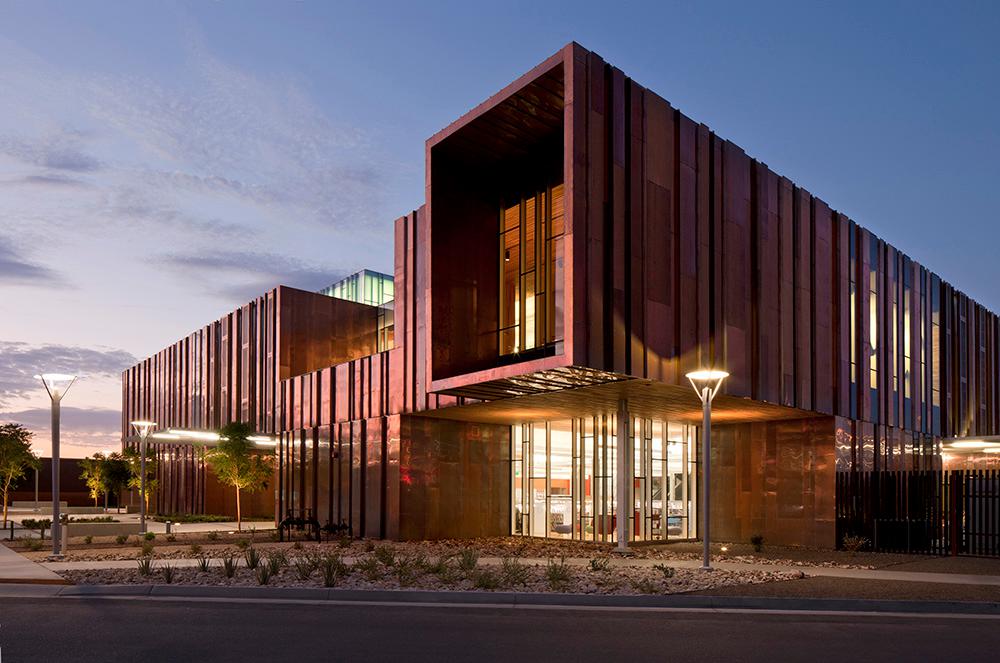
#PUBLIC ARCHITECTURE PROJECTS
South Mountain Community Library
Phoenix is a sprawling desert city that encompasses and is surrounded by a number of mountains.
One within the city limits is South Mountain, home to the largest municipal park in the United States. About one mile north of its namesake mountain is the South Mountain Community Library, serving the public and South Mountain Community College. The copper-clad library is designed by Richärd+Bauer Architecture, who answered some questions about the project.
What were the circumstances of receiving the commission for this project?
Richärd+bauer responded to an RFQ for the South Mountain Community Library. Maricopa County Community College District and the City of Phoenix were looking for a new joint-use facility that integrated the social, academic and educational aspects and functional requirements of a college campus library with the community-based nature of a public library. The new library accommodates the needs of campus requirements for vivid, innovative pedagogy, and the city’s need for a fresh vital community library.
Can you describe your design process for the building?
Form: The architecture of the new Community Library reflects the complexity and interconnected nature of both the information and the programs which it houses. The relatively simple form of the building is derived by the extrusion of program elements both vertically and horizontally, creating opportunities for internal interconnections, exterior views, natural daylight and access to exterior spaces. Modeled after the architecture of an integrated circuit, the building provides insulation between disparate functions and promotes interaction and interconnection between like functions and spaces.
Organization: Due to the duality of the building, it has two entrances; from west and the community college, and east from the public parking. The building integrates the varied uses of a contemporary public library with the needs of an academic media center, allowing for each to function both independently and collaboratively. The public library functions occupy the ground floor, incorporating discrete areas for children, popular library, teens and media collections as well as public meeting rooms, café and technical services. Academic programs affiliated with those within the public library are organized on the second level around vertical interconnected spaces, providing a discrete connection while maintaining critical organization within each discipline.
Materials: The structural steel building is sheathed in a natural copper rain screen, patterned as an abstraction of the digital bar code. Five insulated rooftop lanterns introduce light into the core of the building down to the first level and provide a soft lantern effect during evening operating hours. The interior of the building is lined with cedar strips reinforcing the simplicity of the form; the ventilated surface is a highly absorptive acoustical liner. Abstracted agricultural patterns are digitally imprinted on the skylight liners and laser cut from the surrounding guardrails, tying the building to the history of the area. Recalling the pattern of a circuit board, building systems are organized and expressed within an independent distribution soffit, which also integrates the ambient lighting for the space. Thin accessible flooring provides flexibility for power and data for the changing needs of informational spaces.
How does the building relate to contemporary architectural trends, be it sustainability, technology, etc.?
Libraries are inherently tied to the transformation of informational systems that are changing at an exponential pace. From its earliest inception as a repository of information to its current modality as a spatial/informational interface, the library continues to evolve. The challenge is not to capture a moment in time, but develop an open ended flexibility.
New materials and fabrication techniques are becoming more commonplace and accepted. The ability to cross the boundaries between digital media and the final product has created a new freedom. This applies to the use of digital models for fabrication and ‘software to production’ such as the water jet cut aluminum panels. New adhesives and fabrication processes have allowed us to look at how glazing can be both surface as well as aperture.
Through advancements in building materials and energy modeling data, sustainable buildings do not have to sacrifice quality of design. High performance curtain wall systems allow for floor-to-ceiling glass, uncompromised control of natural daylighting and vision glass that are critical to mitigating energy consumption and maximizing user productivity.
How would you describe the architecture of Arizona and how does the building relate to it?
Contextually, the site was once home to fertile agricultural valleys and groves of citrus. The desire for understanding and reflection of the community and institution has required us to dig deeper into the historical and cultural context of projects. Embedding this into the project has us working as historian, archeologist, arborist and artist. It is manifested as a bosque of trees, reticulated hardscape, ribbons of flower beds and native vegetation inundating the site.
South Mountain Community Library represents the challenge of unifying diverse entities into a cohesive, functioning whole. Simple materials: copper, wood, steel, aluminum, glass and acrylic come together in a straight-forward manner, but are composed in such a way to form a rich, complex expression that is exciting and compelling. Gardens and vegetation uncover the agricultural foundation of the community in rows of indigenous plantings and carefully articulated hardscape while the sun dances off the copper façade alternating with expansive glazing revealing interior spaces. Upon entrance, one is presented with light filtering through the monitors. Graphic patterns, the sinuous glowing mechanical distribution tree, views framing the neighboring mountains, and the warmth of the cedar combine to evoke a complete experience for the patrons.





